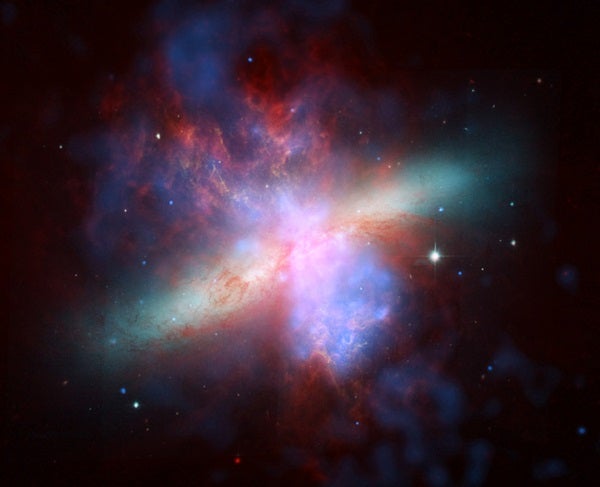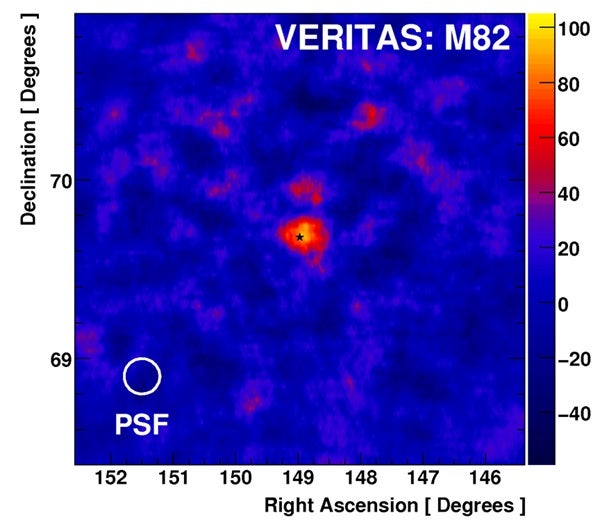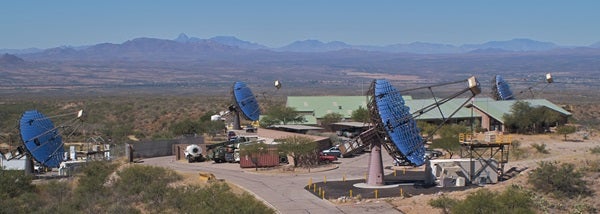Nearly 100 years ago, scientists detected the first signs of cosmic rays — subatomic particles (mostly protons) that zip through space at nearly the speed of light. Even though they are smaller than atoms, the most energetic cosmic rays hit with the punch of a 98mph (158 km/h) fastball. Astronomers questioned what natural force could accelerate particles to such a speed. New evidence from the Very Energetic Radiation Imaging Telescope Array System (VERITAS) shows that cosmic rays likely are powered by exploding stars and stellar “winds.”
These findings were published in the November 1 online issue of the journal Nature, and were featured today in a press conference at the Fermi Science Symposium in Washington, D.C.
The rarest cosmic rays carry more than 100 billion times as much energy as generated by any particle accelerator on Earth. (“Cosmic ray” is a historical misnomer because they are individual particles, not a ray or beam.) Astronomers have devised methods for detecting cosmic rays that hit Earth’s atmosphere. However, detecting cosmic rays from a distance requires more effort.
VERITAS has found new evidence for cosmic rays in the Cigar Galaxy (M82), which is located 12 million light-years from Earth in the direction of the constellation Ursa Major.
“This discovery has been predicted for almost 20 years, but until now no instrument was sensitive enough to see it,” said Wystan Benbow, an astrophysicist at the Smithsonian Astrophysical Observatory. Benbow coordinated this project for the VERITAS collaboration.
The VERITAS observations strongly support the long-held theory that supernovae and stellar winds from massive stars are the dominant accelerators of cosmic-ray particles. Galaxies with high levels of star formation like M82, also known as “starburst” galaxies, have large numbers of supernovae and massive stars. If the theory holds, then starburst galaxies should contain more cosmic rays than normal galaxies. The VERITAS discovery confirms that expectation, indicating that the cosmic-ray density in M82 is approximately 500 times the average density in our Milky Way Galaxy.
“This discovery provides fundamental insight into the origin of cosmic rays,” said Rene Ong, a professor of physics at the University of California, Los Angeles, and the spokesperson for the VERITAS collaboration.
VERITAS could not detect M82’s cosmic rays directly because they are trapped within the Cigar Galaxy. Instead, VERITAS looked for clues to the presence of cosmic rays: gamma rays. Gamma rays are the most energetic form of light, far more powerful than ultraviolet light or even X-rays. When cosmic rays interact with interstellar gas and radiation within M82, they produce gamma rays, which can then escape their home galaxy and reach earthbound detectors.
It took 2 years of data collection to tease out the faint signal coming from M82.
“We knew that the detection of M82 would have important scientific implications,” Benbow said. “As a result, we scheduled an exceptionally long exposure immediately after the experiment became fully operational. The data needed to be meticulously analyzed to extract the gamma-ray signal, which is over a million times smaller than the background noise. Although the signal is only a tiny fraction of the data, we made many checks for possible bias and we are confident that the signal is genuine.”
“The detection of M82 indicates that the universe is full of natural particle accelerators, and as ground-based gamma-ray observatories continue to improve, further discoveries are inevitable,” said Martin Pohl, a professor of physics at Iowa State University who helped lead the study. A next-generation very-high-energy gamma-ray observatory, the Advanced Gamma-ray Imaging System (AGIS), is already under development.
Use Astronomy.com’s interactive star chart, StarDome, to locate and observe M82 in your sky. Click on the StarDome graphic to the right. Be sure to find and set your location under “Location Settings.” After you’ve set your location, click on “Show Names” — located just to the lower right of the star chart — and select “Mark One Specific Object.” Scroll down to find “M82” from the list of objects. Highlight it and click OK.
If M82 is visible from your location, it will appear on the map. Track the object’s motion across the sky by adjusting the figures under “Date and Time Settings.”













